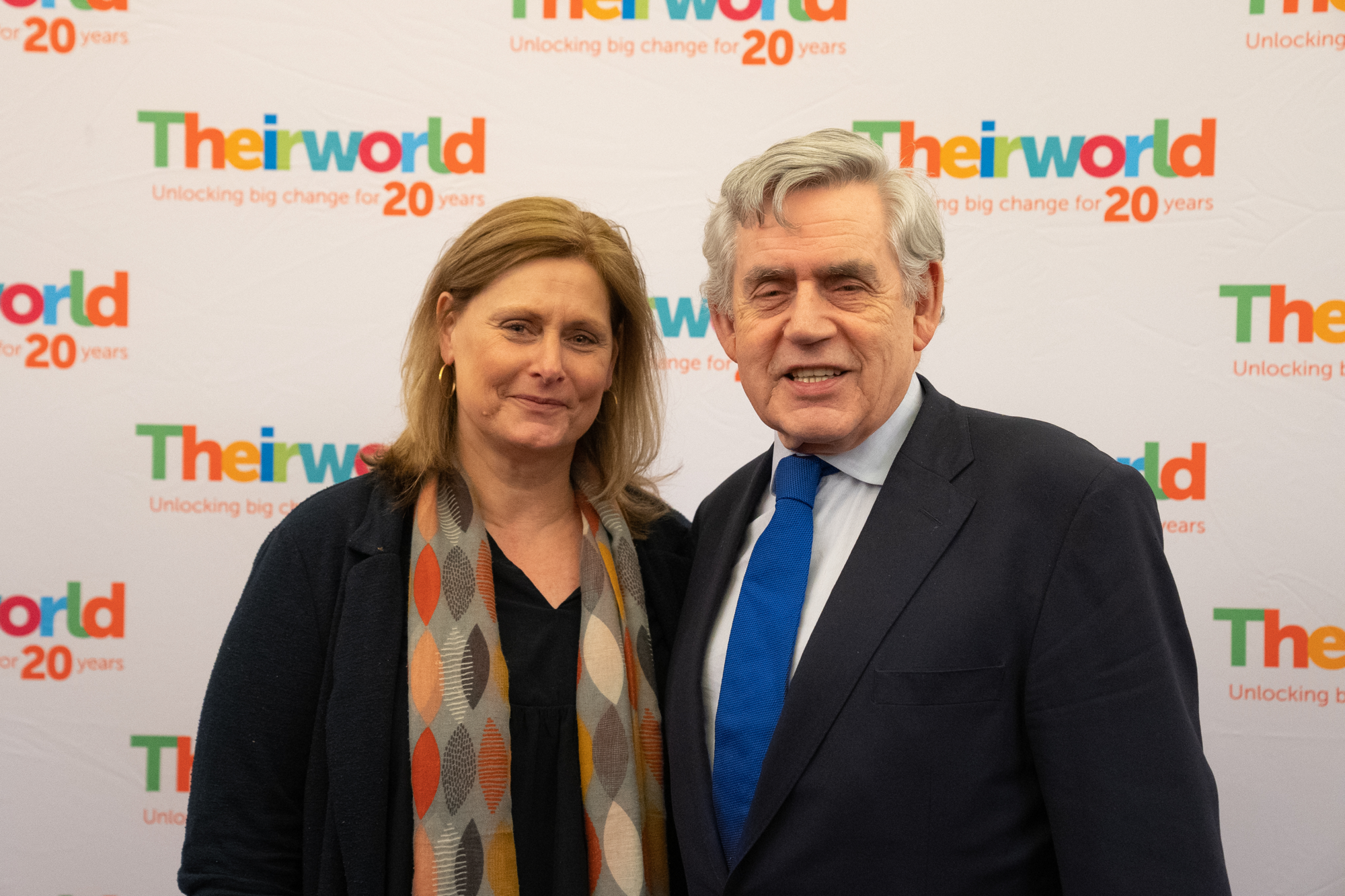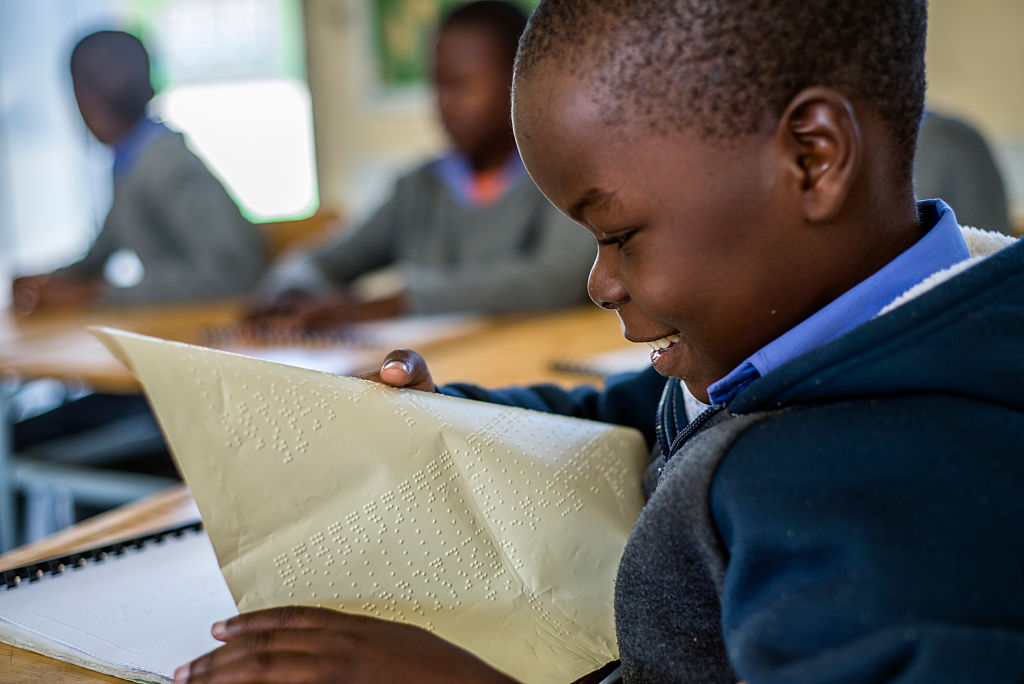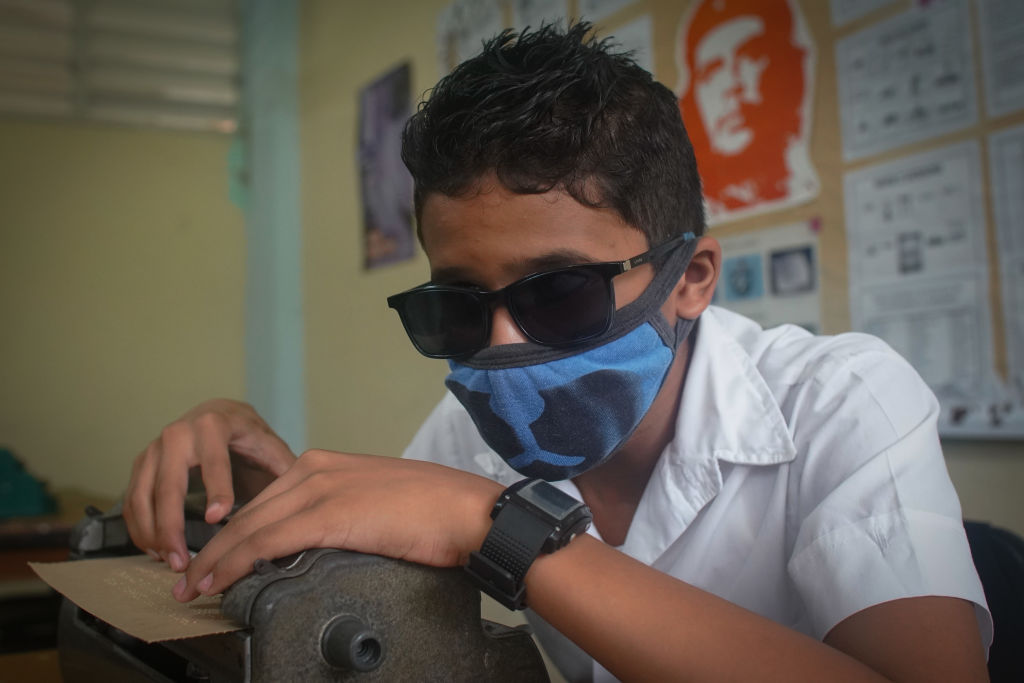
Disabilities and technology: How we can expand inclusive education to achieve SDG4

A new report into assistive technologies in mainstream educational settings by Vibhu Sharma, Theirworld’s Research Consultant, Disability and Inclusion.
Introduction
Inclusive education is a system in which all children, including those with disabilities, are accepted by their neighbourhood schools in age-appropriate, regular classes, and are supported to learn, contribute and participate in all aspects of school life. It means educating children with disabilities in mainstream classrooms alongside their non-disabled peers (Blecker and Boakes, 2010; Haug, 2017).
This ensures that the diverse needs of children with disabilities are met, barriers that may prevent their participation in a common learning environment are diminished, and that they have access to quality education in an accepting, responsive, respectful and supportive environment (Gal et al., 2010). Inclusive education should furthermore concern itself with identifying and overcoming barriers for the continuous, quality and meaningful participation of children with disabilities (Ramchand & Dummugudem, 2014).
The United Nations Sustainable Development Goal 4 states that children with disabilities should have equal access to all levels of education and vocational training. To achieve this by the target date of 2030, it is imperative that the challenges facing children with disabilities in education are overcome and that they are provided an enabling environment in order to reach their full potential. Assistive technology (AT) is critical to achieving that outcome.
Benefits of Assistive Technology
Assistive technology and devices include all those products and services, such as hardware or software, that improve the functioning of persons with disabilities. For children with disabilities, access to AT is the first step for them to be able to go to school, gain an education, and be included in community and society.
AT serves as a powerful tool to enhance a child’s independence and participation. It assists children with disabilities to attain mobility, communicate more effectively, see and hear better, and participate effectively and fully in activities of learning and playing.
Technology has opened up new possibilities and there is growing evidence that it can realize the ambition of inclusive classrooms for children with disabilities. With appropriate AT, persons with disabilities have proven their capabilities and potential to perform on par with their non-disabled peers, be it in education or work (UNICEF, 2017).
Assistive technologies can be simple, such as screen reading software for students with visual impairment, or more complex devices such as speech-generating devices, which require training and greater levels of support. Whatever the level of complexity, AT can help create a level playing field for students with disabilities.
AT helps students with visual impairment access information and reduces barriers to the learning curriculum (Douglas et al, 2011). Technology is also important for the education of students with hearing impairment as it provides accessibility to communication that occurs in the educational settings and also provides a means for delivery of instruction for students with hearing impairment (Stinson, 2018).
AT supports students with learning disabilities by supporting core content areas (e.g., literacy and mathematics) as well as organization and self-management (Courtad and Bouck, 2013).
Assistive technology devices (ATDs) need not always be high-tech technologies, and can sometimes be something as simple as a large printout, or closed captioning in a video. While the use of AT can have a positive effect on children with disabilities, their choice and needs of AT can vary widely, depending on their disability. For instance, children with visual impairment may benefit from materials in braille, notebooks that have raised margins, audio books, and computers with screen-reading software. Children with hearing impairments, on the other hand, require closed captioning or hearing aids. Children with motor disabilities, such as locomotor disabilities, or motor coordination, require the use of a wheelchair, pencil grips and book holders.
Recent major changes in technology have dramatically affected the way we live, study or work, and has also had a significant impact on the ATDs used by students with disabilities. For instance, in contrast to the braille machines that many students with visual impairment used in the past, students can now rely on a regular computer and use a text-to-speech program or a screen-reader to access the same information as their sighted peers. The integration of accessibility features in mainstream technology and devices such as personal computers, tablets and smart phones has improved considerably.
The integration of accessibility features in mainstream devices means more access for students with disabilities to the same opportunities, tools, information and curriculum as their non-disabled peers. There is less need for students with disabilities to be segregated in special education settings. Rather, they can be mainstreamed in general classrooms. Schools and educational institutions furthermore may have to invest less on additional special devices for students with disabilities.
For most people, technology makes things easier. For people with disabilities, technology makes things possible.
Mary Pat Radabaugh
Barriers to inclusive education
Around the world, children with disabilities regularly face discrimination which prevents them from going to school. While efforts towards inclusive education have been made in recent years to enable children with disabilities to study in mainstream education, achieving this in practice continues to be challenging. There are huge disparities between inclusive education policy initiatives and the implementation of inclusive practices in the classroom.
Merely giving children with disabilities a seat in a mainstream classroom won’t achieve much towards achieving inclusion if their special needs are left unmet (Florian, 2008). Those needs can only be met properly when schools take responsibility for introducing accessible education and make the appropriate adjustments to suit the learning needs of every individual (Chong and Graham, 2017).
Despite the mandate of many national and international policies, a disability can leave children facing many challenges and often deny them access to education. Students with disabilities, furthermore, are likely to feel discriminated or left out in a mainstream school due to negative teacher attitudes, discrimination and stigma.
The scale of the challenge to deliver AT to all children with disabilities is very high. According to the World Report on Disability produced by the World Health Organisation (WHO) and the World Bank in 2011, out of 100 million children living with a disability around the world, more than 80 percent are in developing countries. In those countries, about 40 percent and 55 percent of primary and secondary aged children with disabilities, respectively, are out of school, compared to 12 percent and 26 per cent of their non-disabled peers (UNICEF, 2016).
According to a 2018 WHO report, more than one billion people globally (adults and children) require one or more types of AT. Yet only one in ten people have access to an AT device that they need (WHO, 2018). Furthermore, a global report on AT, produced jointly by WHO and UNICEF, states that more than 2.5 billion people need one or more assistive products, e.g. wheelchairs, hearing aids, or applications or software that support communication and cognition. Yet nearly one billion of them are denied access to the AT or products they need, particularly in low- and middle-income countries (LMICs), where access can be as low as three per cent of the need for these life-changing products (WHO and UNICEF, 2022).
It is clear that advances in technology have improved accessibility and have the potential to expand access to learning for many children with disabilities. However, the poor availability of effective AT restricts the fulfilment of the fundamental right to education for children with disabilities (Grönlund et al., 2010).
The high cost of AT remains a prominent obstacle. De Witte et al (2018) highlight that the high cost of good quality AT means many ATDs are available to only those who can afford them out of their own pocket, even in high-income countries.
Even when ATDs are available, access can be hindered by a lack of awareness of that availability, limited government support, inadequate policy and legislation mandating the provision of AT, and a lack of trained teachers and support staff.
The situation in developed or wealthier countries is often not that different to children in the developing world, as many young people with disabilities either leave school with qualifications that are insignificant; or dropout of school as they find lessons irrelevant to their lives, or are sometimes placed in specialist provisions (Ainscow and Miles, 2008).
“What we should prepare for is worldwide access to education for young people, and tell educational institutions that they need to make education accessible to everyone. Then, we need to put pressure on tech companies to sell their devices at costs that are affordable for everyone.” – Gordon Brown, UN Special Envoy for Global Education
Given this context of developments in AT mixed with significant barriers to progress, Theirworld decided to conduct research to identify:
- What are some of the most effective technologies for students with visual, hearing and learning disabilities?
- How are they proving to be effective or useful for students with these disabilities, and for their teachers?
- How can AT be made more available and effective?
- How can more affordable ways of providing and distributing AT be found?
- How can awareness be raised about accessibility features on mainstream devices, so they can be more widely used?
We conducted a survey among:
- children and adolescents with visual, hearing, or learning disabilities
- teachers of children with these disabilities in mainstream schools, and
- assistive technology experts and staff members in non-governmental organisations working in the field.
While ample prior research has indicated that students with visual, hearing or learning disabilities perform well academically and on a par with their non-disabled peers when they have access to AT, there is a lack of research citing the voices of these students, their teachers or experts in the field of AT. We wanted to fill this gap by hearing directly from them, and it is our hope that the thoughtful and revealing responses received will assist the development of policies and initiatives that will place children with disabilities on a level playing field with their non-disabled peers.
The input from three types of respondent and their insight on what AT is useful, how to increase access and how to improve training and awareness, enabled the compilation of several recommendations which are contained at the end of the report.

HAVANA, CUBA – JUNE 02: Jion Luigi Portos,12, writes on a braille typewriter during a class at the special needs school for visually impaired children Abel Santamaria Cuadrado in the Marianao neighborhood on June 2, 2022 in Havana, Cuba. (Photo by Sven Creutzmann/Mambo photo/Getty Images)
International framework
The United Nations Convention on the Rights of Persons with Disabilities (CRPD) defines persons with disabilities as persons who have “long-term physical, psychosocial, intellectual or sensory impairments which in interaction with various barriers may hinder their full and effective participation in society on an equal basis with others” (CRPD, 2006). The definition extends to children with disabilities.
While article 28 of the United Nations Convention on the Rights of the Child mandates signatory countries to ensure that all children have an equal right to free and compulsory education, and that educational and vocational information and guidance is available to all children (CRC, 1989), in recent times numerous international political initiatives have increasingly focused on educating children with disabilities in mainstream education (UNESCO, 2017).
UNESCO’s Salamanca Statement of 1994 explicitly focuses on children with disabilities and stresses on their inclusion in mainstream schools, holding that inclusive education is a system in which all schools are prepared to accept and accommodate all children irrespective of their physical, intellectual, social, emotional, linguistic or other conditions, and which is able to respond to the specific learning needs of every individual (UNESCO, 1994).
The ‘Education for All’ movement launched by UNESCO in 2000 reinforces provision of free and compulsory quality education for children with disabilities (UNESCO, 2000). The CRPD, through article 24 on education, mandates that all children with disabilities can access an inclusive, quality and free primary education and secondary education on an equal basis with other children (CRPD, 2006).
Next resource
